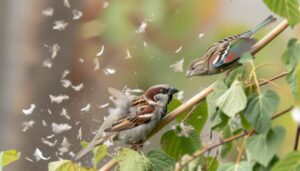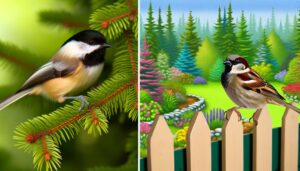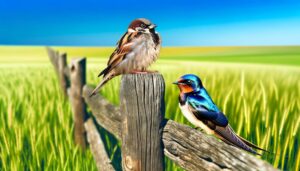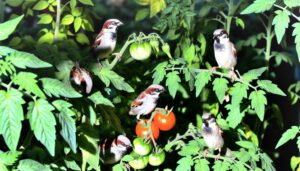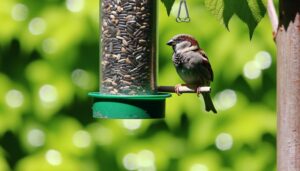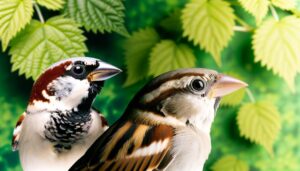Compare 7 Bird Species That Look Similar to House Sparrows
Several bird species exhibit similarities to the House Sparrow (Passer domesticus), providing nuanced identification challenges. The Chipping Sparrow (Spizella passerina) features a distinctive rufous cap and grayish underparts.
The Eurasian Tree Sparrow (Passer montanus) has notable facial markings and cohesive flocking behavior. The American Tree Sparrow (Spizelloides arborea) is recognized by its bi-colored bill.
The Song Sparrow (Melospiza melodia) showcases complex plumage patterns, while the Swamp Sparrow (Melospiza georgiana) thrives in wetland habitats. Field Sparrows (Spizella pusilla) prefer open, grassy areas, and Vesper Sparrows (Pooecetes gramineus) are identified by white outer tail feathers.
The Savannah Sparrow (Passerculus sandwichensis) displays intricate streaking. Intriguing details on these species await exploration.
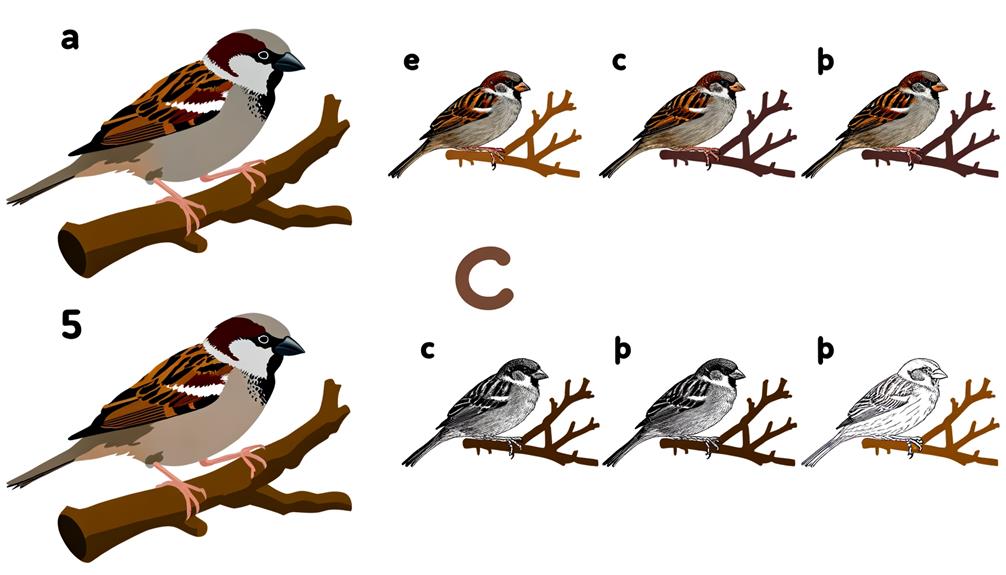
Key Takeaways
- Chipping Sparrow has a rufous cap and grayish underparts, differing from House Sparrow's plainer plumage.
- Eurasian Tree Sparrow displays distinctive facial markings and prefers rural habitats, unlike the more urban House Sparrow.
- American Tree Sparrow features a bi-colored bill and rusty cap, unlike the House Sparrow's uniform bill color.
- Song Sparrow's intricate plumage patterns and varied vocalizations distinguish it from the House Sparrow.
- Savannah Sparrow's fine streaks of brown, gray, and white, and preference for grasslands differ from the House Sparrow's habitat and appearance.
Chipping Sparrow
The Chipping Sparrow (Spizella passerina) is a small, slender bird distinguished from the House Sparrow (Passer domesticus) by its rufous cap, grayish underparts, and a distinctive black eye line. Unlike the House Sparrow's more robust build and brown streaked plumage, the Chipping Sparrow exhibits a more delicate morphology.
It measures approximately 13-15 cm in length with a wingspan of 20-23 cm, making it slightly smaller. Its song, a dry trill, contrasts with the House Sparrow's more variable chirps. Habitat preferences also differ; Chipping Sparrows are commonly found in open woodlands and shrublands, whereas House Sparrows are typically associated with urban and suburban environments.
These distinctions aid in accurate identification and understanding of their respective ecological niches.
Eurasian Tree Sparrow
The Eurasian Tree Sparrow (Passer montanus) can be differentiated from the House Sparrow by its distinctive facial markings, particularly the black cheek spot on a white background.
This species exhibits a preference for rural and suburban habitats, contrasting with the House Sparrow's affinity for urban environments.
Additionally, Eurasian Tree Sparrows demonstrate more cohesive social behavior, often forming large, stable flocks throughout the year.
Distinctive Facial Markings
Prominent black cheek patches and a contrasting chestnut crown distinguish the Eurasian Tree Sparrow from its close relative, the House Sparrow. These distinctive facial markings serve as key identification features in avian taxonomy.
The black cheek patches, located on the white sides of the face, are absent in the House Sparrow, which typically exhibits a more uniform grey or brown head. Additionally, the chestnut crown of the Eurasian Tree Sparrow sharply contrasts with the House Sparrow's grey crown in males or more muted tones in females.
This stark difference in plumage coloration aids ornithologists and birdwatchers in differentiating between these two species, enhancing accurate field identification and contributing to a deeper understanding of their morphological diversity.
Habitat Preferences
Curiously, Eurasian Tree Sparrows exhibit a marked preference for semi-open habitats, including agricultural landscapes, parklands, and suburban gardens, unlike the House Sparrow, which is more commonly associated with urban environments. This distinction is significant as it influences their feeding and nesting behaviors.
Eurasian Tree Sparrows are frequently observed in regions where mixed farming is prevalent, capitalizing on the availability of seeds and insects. Their proclivity for nesting in tree cavities or man-made structures like nest boxes further differentiates them.
House Sparrows, conversely, thrive amidst high human activity, often nesting in building crevices. These habitat preferences underscore adaptive divergences between the two species, allowing each to exploit distinct ecological niches and minimize direct competition for resources.
Social Behavior
Eurasian Tree Sparrows, while adapted to semi-open habitats, exhibit distinct social behaviors characterized by their strong flocking tendencies and intricate communication systems. These birds often form large, cohesive groups, which enhance their foraging efficiency and predator vigilance. Their social structure is underpinned by a complex array of vocalizations and body signals, facilitating effective intra-species communication.
- Flocking Behavior: Eurasian Tree Sparrows frequently gather in large flocks, particularly during non-breeding seasons, to maximize food resource acquisition and predator avoidance.
- Vocal Communication: They utilize a repertoire of chirps and calls, each serving different communicative functions, from alerting danger to maintaining group cohesion.
- Social Hierarchy: A discernible pecking order exists within flocks, influencing access to resources and mating opportunities.
These social strategies are pivotal for their survival and reproductive success.
American Tree Sparrow
The American Tree Sparrow (Spizelloides arborea), distinguished by its bi-colored bill and rusty cap, exhibits morphological and behavioral traits that are both similar to and distinct from the House Sparrow (Passer domesticus).
Morphologically, the American Tree Sparrow has a slender, more elongated body and lacks the black bib characteristic of the House Sparrow. Behaviorally, while both species are ground feeders, the American Tree Sparrow often forms loose flocks in winter and forages in weedy fields, unlike the more urban House Sparrow.
Additionally, the American Tree Sparrow's song is a melodic series of clear notes, contrasting with the House Sparrow's repetitive chirps. These differences aid in accurate identification and understanding of their ecological niches.
Song Sparrow
Notable for its adaptability, the Song Sparrow (Melospiza melodia) exhibits a variety of plumage patterns and vocalizations that differentiate it from the House Sparrow (Passer domesticus).
The Song Sparrow's streaked brown and gray plumage, along with its distinctive central breast spot, contrasts with the House Sparrow's more uniform coloration. Additionally, Song Sparrows are known for their rich, melodious songs, which vary regionally and serve as a key identification feature.
Habitat Preference: Song Sparrows favor marshes, thickets, and gardens, unlike the urban-centric House Sparrows.
Morphology: Song Sparrows possess a longer tail and more delicate build compared to the robust House Sparrow.
Behavioral Traits: They exhibit ground foraging behaviors, often scratching the soil, distinct from the House Sparrow's foraging style.
Swamp Sparrow
Characterized by its preference for wetland habitats, the Swamp Sparrow (Melospiza georgiana) presents a unique set of adaptations that distinguish it from the more widespread House Sparrow (Passer domesticus).
Remarkably, the Swamp Sparrow exhibits a reddish-brown cap and wings, distinct from the House Sparrow's more uniform brown and gray coloration. Behavioral adaptations include a preference for dense, marshy vegetation, contrasting with the House Sparrow's urban and suburban habitats.
Morphologically, the Swamp Sparrow has a slightly longer tail and a more slender build. Its vocalizations, a series of clear, musical trills, differ noticeably from the House Sparrow's repetitive chirps.
These differences, both in physical characteristics and ecological preferences, underscore the Swamp Sparrow's specialized niche within wetland ecosystems.
Field Sparrow
Exhibiting a preference for open, grassy habitats, the Field Sparrow (Spizella pusilla) stands out with its distinct pink bill and clear, melodic song, offering a stark contrast to the urban-adapted House Sparrow (Passer domesticus). Field Sparrows exhibit subtle plumage differences such as a more slender body and a distinctive white eye-ring. Their preference for rural environments markedly reduces their encounters with human habitation compared to House Sparrows.
Key distinguishing features include:
- Bill Coloration: The Field Sparrow's pink bill versus the House Sparrow's darker bill.
- Song: The melodic, whistling song of the Field Sparrow contrasts with the House Sparrow's more monotonous chirping.
- Habitat: Field Sparrows thrive in open fields and grasslands, unlike the House Sparrow's urban settings.
Vesper Sparrow
Among the North American sparrows, the Vesper Sparrow (Pooecetes gramineus) is notable for its distinctive white outer tail feathers and melodious evening song, providing a unique study in contrast to the ubiquitous House Sparrow.
This species exhibits a streaked back and breast, often with a noticeable central spot on the chest, characteristics which can differentiate it from the more uniformly colored House Sparrow.
The Vesper Sparrow's song, a series of clear, musical notes, is typically performed at dusk, hence its name. Habitat preferences also set them apart; Vesper Sparrows favor open fields and grasslands, unlike the House Sparrow, which thrives in urban environments.
These distinctions are essential for accurate identification and understanding of their ecological niches.
Savannah Sparrow
The Savannah Sparrow (Passerculus sandwichensis) exhibits distinctive plumage patterns with its fine streaks and yellowish brow, contrasting the more uniform coloration of the House Sparrow (Passer domesticus).
Habitat preferences also differ markedly, as Savannah Sparrows are typically found in open fields and grasslands, whereas House Sparrows are more commonly associated with urban and suburban environments.
This comparison underscores the importance of specific ecological niches and adaptive traits in the survival and distribution of each species.
Distinctive Plumage Patterns
Characterized by its intricate streaking of brown, gray, and white, the Savannah Sparrow displays plumage patterns that distinctly set it apart from the more uniformly colored House Sparrow. The Savannah Sparrow's back and wings exhibit fine, dark streaks interwoven with lighter shades, creating a mottled appearance that enhances its camouflage in grassy habitats. In contrast, the House Sparrow's plumage is more homogenous, lacking the detailed striping seen in the Savannah Sparrow.
These plumage characteristics are critical for identification.
- Crown: The Savannah Sparrow features a distinct, often yellowish median stripe on its crown.
- Breast: Noticeable streaks on the breast converge into a central spot, unlike the House Sparrow's plain chest.
- Tail: Exhibits a notched tail with white outer feathers, enhancing its distinctive look.
Habitat Preferences
In addition to its distinctive plumage, the Savannah Sparrow exhibits specific habitat preferences, favoring open grasslands and coastal marshes over the urban environments commonly inhabited by the House Sparrow.
This species demonstrates an affinity for native prairies, agricultural fields, and salt marshes, environments that offer ample foraging opportunities and nesting sites.
Unlike the House Sparrow, which thrives in human-altered landscapes, the Savannah Sparrow is more frequently associated with natural and semi-natural habitats, where it can exploit the abundance of insects and seeds.
This preference for less disturbed areas underscores significant ecological differences between the two species, illustrating how habitat selection influences their respective distributions and population dynamics.
Such distinctions are essential for understanding avian biodiversity and conservation strategies.
House Finch
Distinctively different from the House Sparrow, the House Finch (Haemorhous mexicanus) exhibits a more vibrant feathering and a different vocalization pattern, providing a clear basis for comparative ornithological study.
Male House Finches display a bright red coloration on the head, throat, and chest, contrasting sharply with the more subdued, brownish tones of the House Sparrow.
Moreover, the House Finch's song is a melodious series of warbles and trills, differing notably from the House Sparrow's simpler chirps.
- Feathering: Male House Finches have red, orange, or yellow tints, while House Sparrows are mainly brown and gray.
- Vocalization: House Finches produce intricate, musical songs; House Sparrows emit repetitive chirps.
- Size and Shape: House Finches have a more slender build with a longer tail compared to the stockier House Sparrow.
Conclusion
In comparing species similar to the House Sparrow, detailed observation reveals notable distinctions. For instance, the Chipping Sparrow exhibits a distinct rufous cap, unlike the House Sparrow's grey crown.
A hypothetical scenario could involve a novice birdwatcher mistaking a Song Sparrow for a House Sparrow; however, careful examination of the Song Sparrow's streaked breast and melodious song would reveal its true identity.
Such comparative analysis underscores the importance of specific morphological and behavioral traits in accurate avian identification.

